DeArmond and Guild Ashbory Basses: A Comparison
Huge versions of most of the pictures below are available. Click on the pictures
for the larger view (some are over 1 MB in size).
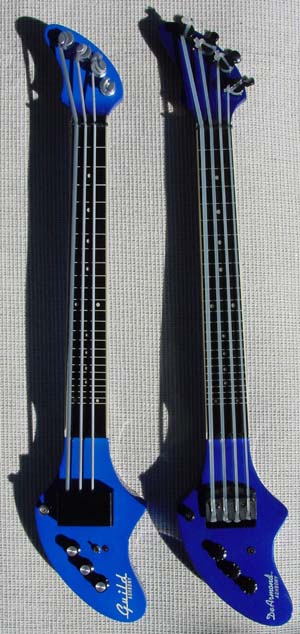
|
The DeArmond and
Fender Ashbory Basses are modeled after the old Guild model. There are some
changes, including improvements. Here's a comparison chart:
|
Guild Ashbory (1986-1988)
|
DeArmond & Fender Ashbory (1999-present)
|
| Body/Neck |
One-Piece
Poplar
|
One-Piece
Agathis
|
Tuning
Machine
|
Adapted Schaller friction
peg ukelele tuners
|
4 geared in-line
reverse
|
Scale
|
18"
|
18"
|
Pickups
|
Ashworth Piezo
|
Ashworth Piezo
(improved)
|
Controls
|
Volume,
Bass, Treble, Active on/off toggle
|
Volume,
Active Bass and Active Treble
|
Active
on status light
|
Red LED
|
Red LED (smaller)
|
Bridge
cover
|
Yes
|
No (but
the bridge is designed to accommodate one a different size than the Guild
one)
|
Fingerboard
|
Plastic with printed
lines
|
Plastic with printed
lines
|
Hardware Finish
|
Nickel
|
Black
|
List
Price
|
$545
$50 gig bag (sold separately)
|
$499.99 (gig bag
included)
|
Manufacturing Location
|
Westerly,
Rhode Island
USA
|
Korea
|
|
Headstock
and Tuners
|
- Tuners: The biggest difference
between the Guild and DeArmond models is the tuners. The old Guild model used
friction tuners based from Schaller banjo tuners. They are bent easily, have
been known to break, and are a hassle to use. The bright side is that they do
work, and can keep tune when you have them locked in. The open geared
DeArmond ones are a treat. They work like tuners should.
- Headstock Size: The headstock is
considerably larger on the DeArmond. This puts the tuners further apart, and
combined with the outward placement of the tuning keys, there is much more
space between each key which is greatly appreciated.
- Headstock profile: The headstock
face is set back much further on the Guild than the DeArmond, which gives the
Guild more downpressure at the nut.
- Headstock heel: The heal on the
heastocks are shaped differently, with a longer, sleeker heel on the
DeArmond.
- Serial Number: The DeArmond serial
number is printed along with "DeArmond" and "Crafted in Korea". There is also
a CE sticker on the headstock. The Guild has the serial number and "MADE IN
U.S.A." indented into the wood.
|
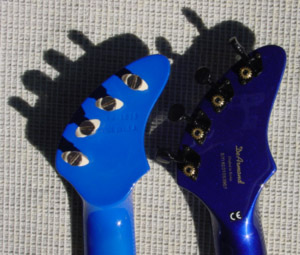
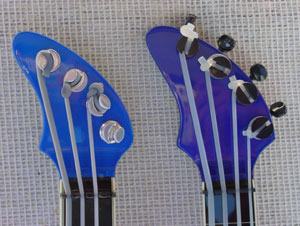
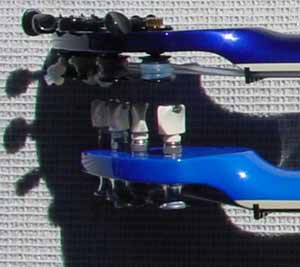
Nut, Strings, and
Neck
|
- Nut: They are different, the Guild
is shiny and rounded, the DeArmond is a piece of plastic. Don't know what the
Guild one is made of but the material seems better. The Guild one is tighter,
possibly too tight.
- Strings: The Guild has a 1998-era
reissue set of Guild formulation strings, matching an NOS set. They are
blue-grey in tint, aren't as soft or sticky, sound better and play better.
The biggest advantage of the Guild is probably the strings, which are no
longer available.
- Fingerboard: Both have printed
fingerboards. The print isn't the same, the Guild has a doublebound look
while the DeArmond looks singlebound. The dots are different sizes as well.
The ends drop off more abruptly on the DeArmond than the Guild.
- Necks: Both feel about the
same.
|
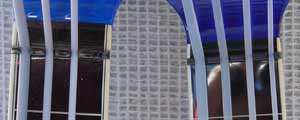
Body, Bridge, and
Electronics
|
- Body shape: They body shapes are
very similar. The most noticable difference in sillouette is that the Guild
has a sharper bottom point and the DeArmond has a sharper top
point.
- Knobs: The Guild knobs have silver
caps and a dot on the outside rim for level indication. The DeArmond knobs
have odd numbers around the rim for level indication. The pots on the Guild
are normal operation, but the Bass and Treble knobs on the DeArmond have a
notched area at 5.
- Active/Passive toggle:The Guild has
one and the DeArmond does not. The toggle is a nice feature, though the
passive mode is of little interest to most compared to the active mode, it
offers more flexability, not to mention it alows one to bypass a weak battery
during a gig if necessary.
- Straplocks: Both have metal
straplocks, black ones on the DeArmond and Nickel ones on the DeArmond. The
DeArmond ones actually look a bit beefier, but the Guild ones are more than
sufficient. Both share about the same locations.
- Active status LED: Both have active
status LED lights. Both are red, but the DeArmond one is smaller.
- Pickup/Bridge: The bridges are of different shapes, but are about
the same size. The Guild has 3 mounting screws in a line, whereas the screws
for the DeArmond form a triangle, since the middle screw is on an added peak
in front of the saddle. Both have Ashworth transducers, but the DeArmond is
newer and should outperform an original Guild (the Guild pictured had the
pickup rebuilt in 1996).
- Bridge Cover: No bridge cover for
the DeArmond, though there are attachment points on the sides of the pickup
to support one. The Guild has a pickup cover (see image at the top of this
page) but due to a difference in attachment poinrt spacing, it will not fit
on the DeArmond Pickup.
- Input jack: They look similar from the outside. Both have a
Nickel finish, and the DeArmond has a larger washer at the body.
- Neck heel: Very similar between both
models.
- Rear Plate: Both are about the same
shape, the DeArmond one is more deluxe and thicker in appearence. Both use
black screws for retention, the guild ones have flat heads while the DeArmond
ones are larger with domed heads.
|
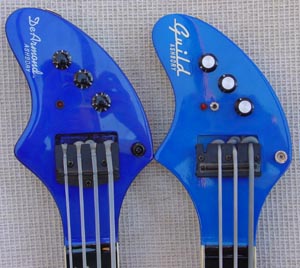
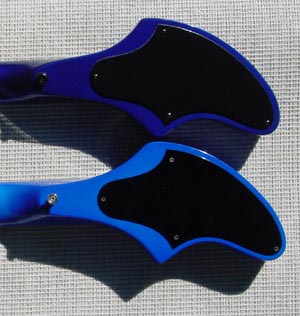
Other
Stuff
|
- Paint hue: The blue paints are
certainly not the same, the Guild has a very simple blue, while the DeArmond
blue has a tiny amount of flake, and is a darker shade with a hint of
purple.
- Paint smoothness: To my surprise, the Korean DeArmond finish is much
smoother than the USA made Guild. Look at the reflections in the headstock
fronts and body fronts pictures for an idea of the
difference.
- Playability: Both play about the
same. The biggest difference is the strings.
|
In a nutshell: The DeArmond is an improved version of the classic Guild model.
Though Korean made, it plays well and has a smoother finish than USA made Guild. The
new geared tuners are a dramatic improvement over the friction pegs used by the
Guild. Though the Guild has superior strings (that would work on a DeArmond) and has
a nice active/passive toggle, the tuners alone make the DeArmond the superior
instrument.







